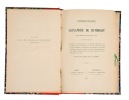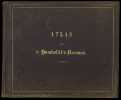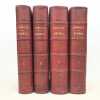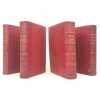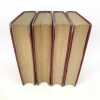75 books for « humboldt a von »Edit
-
Century
18th (1)
19th (35)
20th (16)
21st (2)
-
Countries
Belgium (2)
Denmark (19)
France (37)
Switzerland (17)
-
Syndicate
ILAB (62)
NVVA (9)
SLACES (9)
SLAM (28)
Topics
- Architecture (1)
- Asia - orient (1)
- Astronomy (2)
- Atlas (1)
- Balzac honoré de (1)
- Botany (3)
- Chemistry (1)
- Early printed books (1)
- Esther (2)
- Ex-libris (1)
- First edition (4)
- Gay lussac (1)
- Geography (6)
- Geology (2)
- German literature (5)
- Germanic languages (12)
- Germany (3)
- Goethe johann wolfgang (1)
- Graphic art (1)
- Himalayas (1)
- History (10)
- Honduras (1)
- Humboldt alexander von (3)
- Literature (3)
- Manuscripts (1)
- Medicine (3)
- Memories (4)
- Mexico mayas (2)
- Napoleon i (1)
- Newspaper (1)
- Newspapers press (1)
- Number (1)
- Paris (2)
- Philology (1)
- Philosophy (4)
- Physics (2)
- Poetry (1)
- Prussia (1)
- Psychology (1)
- Reliure (1)
- Review (2)
- Savignac (2)
- Sciences (10)
- Sciences & technique (1)
- Second empire (1)
- Siberia (1)
- Tea (1)
- Translation (1)
- Travel (4)
- Various (5)
Über die Verschiedenheit des menschlichen Sprachbaues und ihren Einsfluss auf die Geistige Entwickelung des Menschengeschlechts. - [THE PHILOSOPHY OF SPEECH - PMM 301]
Berlin, 1836. 4to. Bound with the original patterned end-papers in a later red leather binding with raised bands and gilding to spine. First and last leaves with a bit of light brownspotting. XI, (1), 511 pp.
First edition of this classic study of human language, which founded the metaphysics of language - Humboldt's philological testament that founded the theory of the structure of language as the expression of the character of the language-speakers. Up until Humboldt and his ""On the Diversity of Human Language..."" [i.e. the present work], language was viewed as a dead means of communication, as a mere thing. With the present work, a completely new approach to language is founded, one that forms the basis of modern linguistics and upon which linguistic thought and philosophy is now based: ""Language is not a finished thing at rest, but something that at every moment emerges, comes into being, and perishes"" it is not so much a dead product, but far more a continuously active production... Language is the forming organ of thought."" (from the present work). Humboldt died while preparing his magnum opus, on the ancient Kawi language of Java, which thus remained a fragment, but which was published the year after his death (1835), in 1836. The present work, the most important of his productions and the final statement of his lifelong study of language, served as a general introduction to this. This lengthy foreword was completed by Humboldt himself and after his death edited by his younger brother, the great traveler and naturalist Alexander von Humboldt. It was published both as a separate treatise, as here, and as the introduction to the ancient Kawi language of Java. ""On the Diversity of Human Language…"" remains one of the most important attempts at drawing philosophical conclusions from comparative linguistics. This founding work of philosophy of speech ""... first clearly laid down that the character and structure of a language expresses the inner life and knowledge of its speakers, and that languages must differ from one another in the same way and to the same degree as those who use them. Sounds do not become words until a meaning has been put into them, and this meaning embodies the thought of a community. What Humboldt terms the inner form of a language is just that mode of denoting the relations between the parts of a sentence which reflects the manner in which a particular body of men regards the world about them. It is the task of the morphology of speech to distinguish the various ways in which languages differ from each other as regards their inner form, and to classify and arrange them accordingly."" (Encycl. Britt.). With this work, Humboldt founds a theory of language that becomes the basis of modern thought on the subject. The basis being the identification of human language as a rule-governed system (and not merely a collection of words and phrases paired with meaning). Chomsky's thory of language, for instance, is based on Humboldt's. Humboldt has also been credited as an originator of other linguistic theories, such as the linguistic relativity hypothesis, and as the originator of the term ""worldview"". As Alfred Dove points out [in ""Portraits of Linguists"", edt. by T.A. Sebeok], the philosophy of language that Humboldt presents in the present work should remind one of the main works by his master, Immanuel Kant, as they present a fundamental critique of the capabilities of language. Humboldt's purely organic theory of the origin and essence of language, of the way it lives and works, not only forms the basis of certain strands of modern linguistics, it fundamentally does away with the entire mechanic comprehension of purely philological doctrine, paving the way for a metaphysical and more complex understanding of language and human nature. Dove compares the success and influence of the linguistic theory of the present work to what happens in the fundamental work ""Kosmos"" by Humboldt's younger brother, Alexander. Both had the ability to unite the bold sweep of the universal tendency of the 18th century with the prudent method of individual scientific investigation of the 19th century. ""In this, his philological testament, Humboldt attempts the classification of peoples according to language. More important than the classification itself was the corollary to it, which seemed to Humboldt to imply that the development of individual languages is affected by physiology, ethnography, history, geography, political and religious relationships, and that stages in the cultural development of peoples leave strongly marked traces in their languages. In the words of A.H. Sayce, a great philologist of our own day: ""This essay first clearly laid down that the character and structure of a language expresses the inner life and knowledge of the speakers, and that languages must differ from one another in the same way and to the same degree as those who use them... What Humboldt terms the inner form of the language is just that mode of denoting the relations between the part of a sentence which reflects the manner in which a particular body of men regards the world about them.""
Reise in die Aequinoctial-Gegenden des neuen Continents. In deutscher Bearbeitung von Hermann Hauff. 4 Teile in 2 Bänden.
Stuttgart, J.G. Cotta, 1859-60, in-8vo, XIII/403/416/403/444 S. + 1 gefaltete Karte (lose beiliegend) in Lithogr. (von C. Monecke in Berlin nach Zeichn. von Henry Lange), im Allgemeinen sauber, vereinzelt gering braunfleckig meist am Rand, Halbleder Bde. Sehr gutes Exemplar.
Erste Ausgabe der “einzigen von A. v. Humboldts anerkannten Ausgabe in deutscher Sprache”. Nachdem die erste Übersetzung von Humboldts Bericht über die "in den Jahren 1799-1804 in Gesellschaft von Bonpland unternommene Reise in das tropische Amerika" durch Therese Huber und ihren Sohn Victor Aime als "gänzlich verfehlt" angesehen werden mußte, hat Cotta den Bruder Wilhelm Hauffs beauftragt, eine neue Bearbeitung unter Mitwirkung des Autors zu erstellen. Humboldts "Mitarbeit" beschränkt sich allerdings nur auf das kurz vor seinem Tode verfasste "Vorwort". Den von Hauff vorgenommenen Kürzungen stimmte Humboldt zugunsten eines besseren Leseflusses zu. Die erste deutsche Version von 1815-32 war eine von Humboldt nicht anerkannte Übersetzung, besorgt von einem Konsortium. Fiedler u. Leitner 4.1.2.2; Loewenberg 123; Beck II/69 f u. Anm. 417 u. 419; Sabin 33738.

(SLACES, NVVA)
Phone number : 41 (0)26 3223808
Correspondance de Alexandre de Humboldt avec Varnhagen von Ense, de 1827 à 1858, accompagnée d’extraits du journal de Varnhagen, LL. MM. les rois de Prusse et de Danemark, le grand-duc de Toscane, la duchesse d’Orléans, le prince Albert, le prince de Metternich, MM. Guizot, Thiers, Arago, lord John Russell, Napoléon Bonaparte, etc. Traduction de l’allemand par Max. Sulzberger.
Paris, Bohné ; Bruxelles, Van Meenen, 1860 ; in-16, bradel de percaline rouge vif, pièce de titre vert foncé, chiffre couronné doré Philibert de Lombard de Buffières, comte de Rambuteau en pied du dos, date en queue (reliure de l’époque) ; XII-494 pp.
Edition originale ; un double feuillet in-4° replié supportant trois pages manuscrites du comte de Rambuteau qui estime que cette édition est bien meilleure que celle traduite par Girard et publiée par Hehl, Hachette et Lacroix, in-8°. La Préface est de Ludmilla-Assing (nièce de Varnhagen).Ecrivain, historien et diplomate, membre du groupe de poètes romantiques allemands la “Nordsternbund”, Karl August Varnhagen a épousé en 1814 l’écrivaine Rahel Levin, d’une famille juive, mais elle décida de se convertir. Elle va tenir un célèbre salon littéraire qui est fréquenté par des écrivains, scientifiques, politiciens et aristocrates dont Alexandre de Humboldt, Hegel, Henrich Heine, Friedrich Schlegel, Friedrich de la Motte-Fouqué, etc... et le couple rendra visite à Goethe à plusieurs reprises !L’oeuvre littéraire de Rahel Varnhagen sera surtout constituée d’une correspondance importante qui sera publiée après sa mort en 1833, et de son journal. Cette correspondance d’Alexandre de Humboldt est d’importance, sa proximité, son intimité avec Varnhagen lui permet d’écrire nombre de faits ou de pensées très personnels. Très bel exemplaire, d’une provenance tout à fait intéressante. Dos à peine éclairci !


Phone number : 06 60 22 21 35
Kosmos. Entwurf einer physischen Weltbeschreibung. – Dabei: Bromme Traugott: Atlas zu Alex. v. Humboldt's Kosmos.
4 Bände + Atlasband. Stuttgart und Augsburg, Cotta und Krais & Hoffmann, 1845–1858. Quer-4°. XVI, 507 S.; (1) Bl., 535 S.,; (1) Bl., 645 S.; (1) Bl., 690 S., Atlas: (2) Bl., 136 S. Mit 42 Tafeln (davon 39 Karten mit Grenzkolorit). Blind- und goldgeprägte Orig.-Leinenbände.
Löwenberg 199. - Errschien gleichzeitig in Tübingen und Stuttgart. Der Atlas in der Ausgabe von 1851. Die Textbänd in kleinoktav (Volksausgabe). Wichtiges, wenn nicht das wichtigste Werk von Alexander von Humboldt (1769-1859). Es erschien 1862 in Tübingen und Stuttgart noch ein fünfter Textband. Mit zeitgenössischer handschr. Widmung auf dem fliegenden Vorsatz. - Das Papier durchgehend gebräunt und stockfleckig. Die Einbände berieben. Die Rücken verblichen.

Phone number : 41 (0)44 261 57 50
Über die Haupt-Ursachen der Temperatur-Verschiedenheit auf dem Erdkörper. Gelesen in der öffentlichen Versammling der Königlichen Akademie der Wissenschaften zu Berlin am 3. Julius 1827. - [DEVELOPING CLIMATOLOGY AS A SCIENCE IN ITSELF]
Berlin, 1827. 4to. Uncut and unopened in cont. (orig.?) blank wrappers. Some tears to edges and a bit of soiling. Otherwise fine, nice and clean. 24 pp.
First edition, off-print, of Humboldt's important paper on climatology. The speech was printed in ""Abhandlungen der Königlichen Akademie der Wissenschaften zu Berlin, Physikalische Klasse, 295-315. In 1827 Humboldt left Paris to move back to his native city Berlin. He was hired by the King of Prussia to report on cultural and scientific matters. Here, he gave a number of lectures on physical geography that were immensely popular. The present paper is one of these, in which he attempted to show that science was the way to learn about nature, as opposed to mere intuition. Humboldt showed that science was the way to ascertain knowledge on empirical matters. His ""Über die Haupt-Ursachen..."" occupies a central place in Humboldt's contributions to the founding of modern climatology. Several ideas that are developed further in his later works dealing with climatology, e.g. ""Kosmos"" are formulated in this work.Humboldt not only deals with climatology in general, but also deals with the relation of the distribution of heat on the surface of the earth to agriculture and business, and even to politics and sociological matters, thus establishing a sort of climatology-economics.
Essai géognostique sur le gisement des roches dans les deux hémisphères
Paris, F.G. Levrault, 1823, in-8, 8-VIII-379 pp, Broché, couverture imprimée de l'éditeur, sous emboîtage moderne, Première édition, publiée simultanément en français et en allemand (Geognostischer Versuch über die Lagerung der Gebirgsarten in beiden Erdhälften, Strasbourg, Levrault) du principal ouvrage géologique d'Alexander von Humboldt (1769-1859). Exemplaire enrichi, en couverture, d'un envoi autographe, non signé, de l'auteur : "à Monsieur Juncker à Poullaouen, de la part de l'auteur". Chrétien-Auguste Juncker (1791-1865), savant et ingénieur en chef des Mines, fut directeur des mines de Poullaouen et Huelgoat, dans le Finistère, entre 1816-1841 ; Humboldt, qui y avait été accueilli en 1813, remarqua la grande ressemblance entre les "terres rouges" de ces mines et le minerai argentifère de Potosi au Pérou. Ce type de découverte sert le propos de son Essai géognostique, dans lequel il exprime sa pensée géologique et tente, pour la première fois, de comparer les roches de l'Ancien et du Nouveau Mondes. Si la doctrine "neptunienne" de son maître Werner s'aperçoit en filigrane, Humboldt a néanmoins pris ses distances. Il affirme la théorie magmatique du volcanisme et fait apparaitre deux concepts fondamentaux de la géologie dynamique : celui de roches endogènes (éruptives) et celui de roches exogènes (sédimentaires). Il démontre ainsi les relations entre le volcanisme et les structures terrestres. Première de couverture rapportée. Manque angulaire en quatrième de couverture, déchirure sans manque à un feuillet. DSB VI, 554. Poggendorff I, 1158. Ward & Carozzi, n°1136. Couverture rigide
Bon 8-VIII-379 pp.
Journal parisien (1797-1799).
Solin/Actes Sud, 2001, gr. in-8°, 355 pp, traduit de l'allemand, préface d'Alberto Manguel, notes, index raisonné des noms de personnes, broché, couv. illustrée, bon état
Imprégné des Lumières, Wilhelm von Humboldt séjourne à Paris entre 1797 et 1799. Durant cette période riche et mouvementée, il tient un journal, qu'il conçoit comme une véritable enquête anthropologique. Dans ce dessein, Humboldt rencontre toutes les personnalités marquantes de la capitale : Bonaparte, Sieyès, Mme de Staël, Benjamin Constant, pour ne citer qu'eux. Il fréquente assidûment assemblées, instituts, théâtres et salons ; prend de nombreuses notes de lectures ; dépeint enfin, non sans humour et avec un sens aigu du pittoresque, la société d'alors. Encore inédit en France, le journal parisien est un document exceptionnel sur la vie politique et culturelle sous le Directoire. Il contribuera à faire découvrir au public français, à travers un chapitre de sa propre histoire, la richesse de la pensée de Humboldt et sa profonde originalité.
Lettres de Alexandre de Humboldt à Varnhagen von Ense (1827-1858)
Genève, Paris, Bruxelles L. Held, L. Hachette et Cie, A. Lacroix van Meenen et Cie 1860 pet. in-8 demi-veau chamois, dos à nerfs, pièces de titre bleu nuit et vert bronze [Rel. de l'époque], manque la coiffe sup., mors très légèrement frottés
Frontispice, xvi et 285 pp.Brunet, III, 376. Pas dans Quérard, ni Vicaire. Première édition de la traduction française, parue la même année que l'originale allemande.Portrait de Humboldt gravé sur acier par A. Weger en frontispice. Traduction française par Charles François Girard, qui signe également la préface. Il existe une édition française plus complète (Brunet), sous un titre un peu différent, à la même date (Bruxelles, Leipzig, Aug. Schnée ; Bruxelles, Fr. van Meenen). Karl August Varnhagen von Ense (1785-1858) était un écrivain et diplomate allemand, personnage peu connu de la vie intellectuelle allemande du XIXe siècle, et joua un rôle crucial en entretenant une intense correspondance avec les têtes pensantes de l'époque. Sa nièce, Ludmilla Assing, a publié après sa mort plusieurs volumes de sa correspondance avec Humboldt, Metternich, Heine, Chamisso, etc.
Briefe Alexander von Humboldt an seinen Bruder Wilhelm. Hrsg. v. d. Familie von Humboldt in Ottmachau.
Stuttgart, Cotta, 1880 in-8vo, LXXXVIII (Einleitung) + 228 S., Original-Broschüre Rücken mit Papier verstärkt. (S. teilw. lose. Ex. zum Binden). Softcover.
I) Aus der Zeit - der Reise in Amerika / II) - des Aufenthalts in Paris / III) - der Reise in Russland / IV) Anhang.

(SLACES, NVVA)
Phone number : 41 (0)26 3223808
Versuch über die astronomische Strahlenbrechung in der heissen Zone für Höhenwinkel unter 10 (degree), insofern sie von der Wärmeabnahme abhängt. Frei übersetzt von Gilbert.
(Leipzig, Johann Ambrosius Barth, 1809). Without wrappers as issued in ""Annalen der Physik und der Physikalischen Chemie. Hrsg. Ludwig Wilhelm Gilbert"", Bd. 31, Viertes Stück. Pp. 337-452 a. 1 engraved plate. (The entire issue offered). Humboldt's paper: pp. 337-397.
First edition of Humboldt's large paper on the refraction in the atmosphere and his caloric theory of absorption. - Darmstaedter 1809 H.
Geognostische und physikalische Beobachtungen über die Vulkane des Hochlandes von Quito. Erste- (Zweite Abhandlung).
Leipzig, Johann Ambrosius Barth, 1837-38. Without wrappers as issued in ""Annalen der Physik und Chemie. Hrsg.von Poggendorff"", Bd. 40, No 2 and Bd. 44, No.6. Pp. (161-) 320 a. pp. (193-) 368. (2 entire issue offered). Humboldt's paper:pp. 161-193 a. 193-219.
Fisr printing of Humboldt'd famous description of the major vulcanoes around Quito in Ecuador.
Atlas géographique et physique de la Nouvelle-Espagne. Vom Verfasser auch kurz benannt: MEXICO-ATLAS. Besorgt von Hanno Beck und Wilhelm Bonacker. = Quellen und Forschungen Zur Geschichte der Geographie und der Reisen, Bd. 6,
Stuttgart, F.A. Brockhaus, 1969, in-Folio, 34 S. (liste des cartes + Einführung und Beschreibung d. Tafeln (in deutscher Sprache) ) + XCII (= 92 p. analyse raisonnée et introduction géographique) (en français) + page de titre de l’édition de 1812 + 28 meist gef. Karten und Ansichten, Original-Leinenband. Orig.-Umschlag (OU leicht fleckig).
Folio, full clothbound with jacket (jacket a bit stained & repaired, no loss - cloth bound book in fine condition). A large and detailed colonial geographical atlas of New Spain (Mexico) by world renowed German naturalist and explorer Alexander von Humboldt, (1769-1859). Reproduced texts printed in French and German after the Atlas du Royaume de la Nlle-Esp. (1812) & Atlas du Nouveau continent (Paris 1814) & (Plate 28: Volcan de Jurolla): Vue des Cordillères Paris 1810. This edition complete with 28 plates (Liste of plates on demand). image disp.

(SLACES, NVVA)
Phone number : 41 (0)26 3223808
Briefe von Wilhelm von Humboldt an eine Freundin. Zweite unveränderte Auflage. 1.-2. (2 Bde).
Leipzig, Brockhaus, 1848. 2 contemp,. hcalf. Raised bands, blindtooled decor. on spine. XIV,381XXII,312 pp. a. 1 facsimile. Clena and fine.
BRIEFE VON WILHELM VON HUMBOLDT AN EINE FREUNDIN
F. A. Brockhaus, Leipzig. 1874. In-12. Relié. Etat d'usage, Couv. légèrement passée, Dos fané, Mouillures. 504 pages. Fac-similé en noir et blanc en frontispice. Texte en allemand et en caractères gothiques. Titres et motifs dorés sur le dos et le 1er plat. Tranche dorée. Etiquette de code sur la couverture. Quelques tampons de bibliothèque. Dos et partie du 1er plat insolés. Quelques rousseurs.. . . . Classification Dewey : 430-Langues germaniques. Allemand
Vierte Auflage der Ausgabe in Einem Bande. Mit einem facsimile. Classification Dewey : 430-Langues germaniques. Allemand
"HUMBOLDT, ALEXANDER von. - ON THE SNOW-LINE OF THE HIMALAYA.
Reference : 44059
(1820)
Sur la Limite inférieure des neiges perpétuelles dans les montagnes de l'Himâlaya et les régions équatoriales.
Paris, Crochard, 1820. Uncut in orig. printed wrappers. In ""Annales de Chimie et de Physique, Par MM. Gay-Lussac et Arago."", Tome XIV - Mai 1820. The entire issue offered. Htitle a. titlepage to vol. 14. (4),112 pp. Humboldt's paper: pp. 5-56. Clean and fine.
First appearance of Humboldt's importent investigation of the snow-line in the Himalayas. He found, that the snow-line on the northern side of the Himalaya is much higher than below the equator, and that there is a connection between the lowest line of the permanent snow, the oscillations of the snowl-line and the lowest line of snowfall.The issue also contains the importent chemical paper by PELLETIER & CAVENTOU ""Examen chimique de plusieurs végétaux de la famille des colchicées, et du principe actif qu'ils renferment. (Cévadille (veterum album)"" colchique commun (colchicum autumnale))."", pp. 69-83.
Nouvelles Recherches sur les lois que l'on observe dans la distribution des formes végétales.
Paris, Crochard, 1821. Uncut and unopened in orig. printed wrappers. In: Annales de Chimie et de Physique, Par MM. Gay-Lussac et Arago."", Tome 16 - Mars 1821. Pp. 225-336 a. 1 folded engraved plate. (Entire issue offered (Mars-issue). Humboldt'd paper: pp. 267-296 a. 1 folded table.
One of Humboldt's importent investigations on plant geography.
Nouvelles Recherches sur les lois que l'on observe dans la distribution des formes végétales.
Paris, Crochard, 1821. 8vo. As extracted. In: Annales de Chimie et de Physique, Par MM. Gay-Lussac et Arago."", Tome 16 - Mars 1821. Pp. Humboldt'd paper: pp. 267-296 a. 1 folded table.
One of Humboldt's important investigations on plant geography.
Cosmos, essai d’une description physique du monde.
1848-1859 Paris, Gide et J. Baudry, 1848-1859.
4 volumes in-8 (20,7 x 13 cm), demi chagrin rouge (reliure de l’époque), dos à caissons à froid, [4]-vii-1 bl.-viii-580 ; xiv-[2]-636; viii-[2]-764; vii-[1]-806 pages (complet). Couvrure et coins frottés, rousseurs. État très correct. Quatrième édition chez le même éditeur de cet ouvrage capital d’un des plus grands savants et voyageurs. Magistrale synthèse traduite de l’allemand par Charles Galuski et Hervé Faÿe. Première édition allemande en 1845. L’ouvrage comprend une description du ciel et de la terre, un essai sur le développement de l’univers et de nombreuses explications des phénomènes célestes et terrestres, formant un véritable panorama du monde. Alexander von Humboldt (1769-1859) est un naturaliste, géographe et explorateur allemand. Il était membre associé de l’Académie des sciences française et président de la Société de géographie de Paris. Par la qualité des relevés topographiques et des prélèvements de faune et de flore effectués lors de ses expéditions en Amérique Centrale et du Sud, puis en Sibérie, il a fondé les bases des explorations scientifiques. Bon exemplaire.
Briefwechsel zwischen Alexander Von Humboldt und Carl Friedrich Gauss. Neu herausgegeben durch Kurt-R. Biermann.
Berlin, Akademie Verlag, 1977, gr. in-8vo, 202 S., + 4 s./w. Tafeln, Original-Leinenband mit OU.

(SLACES, NVVA)
Phone number : 41 (0)26 3223808
Briefe über Alexander von Humboldt's Kosmos. Ein Commentar zu diesem Werke für gebildete Laien. 1.-3. Theil.
Leipzig, Weigel, 1848-55. 3 cont. hcalf. Raised bands, gilt backs. X,356,(2),IV,482,V,468 pp., 18 lithographed plates (1 handcoloured), 1 fold. table, 4 astronomical plates(of which 2 are handcoloured), many textillustr.
First edition. - A fourth volume was issued in 1860.
Vier Jahrzehnte Wissenschaftsförderung. Briefe an das preussische Kultusministerium 1818-1859.
Berlin, Akademie-Verlag, 1985. Gr.-8°. 252 S. Orig.-Leinenband mit Schutzumschlag.
Aus der Reihe: "Beiträge zur Alexander-von-Humboldt-Forschung", 14. Band.
Tableaux de La Nature. Alexandre De Humboldt. v 1.
2 (von 3) Bände. Paris, Firmin Didot Freres, 1850. 8°. III, (1), 312 S.; (2) Bl., 363, (1) S. Halblederbände der Zeit.
Ohne den Atlasband. - Titelblatt gestempelt. Einbände berieben.
Wilhelm von Humboldt. Lebensbild und Charakteristik.
Berlin, 1856. Cont. boards. Back loosening. XIV,641 pp. Brownspotted.
 Write to the booksellers
Write to the booksellers